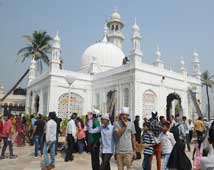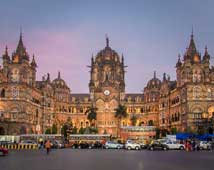
Following the first war of Independence in 1857, the East India Company was accused of mismanagement, and Bombay reverted to the British crown. With the outbreak of the American Civil War in 1861, and the opening of the Suez Canal in 1869, exports, specially cotton, from Bombay became a major part of the colonial economy.
The Great Indian Peninsular Railway facilitated travel within India. This network of commerce and communication led to an accumulation of wealth. This was channelled into building an Imperial Bombay by a succession of Governors. Many of Bombay's famous landmarks, the Flora Fountain and the Victoria Terminus, date from this time.
The water works, including the Hanging Gardens and the lakes were also built at this time. The Bombay Municipal Corporation was founded in 1872. However, this facade of a progressive and well-governed city was belied by the plague epidemics of the 1890s. This dichotomy between the city's symbols of power and prosperity and the living conditions of the people who make it so continues even today.
The construction of Imperial Bombay continued well into the 20th century. Landmarks from this period are the Gateway of India, the General Post Office, the Town Hall (now the Asiatic Library) and the Prince of Wales Museum. Bombay expanded northwards into the first suburbs, before spreading its nightmare tentacles into the the northern suburbs. The nearly 2000 acres reclaimed by the Port Trust depressed the property market for a while, but the Backbay reclamation scandal of the '20s was a testament to the greed for land.
The freedom movement reached a high pitch of activity against this background of developing Indian wealth. Gandhi returned from South Africa and reached Bombay on January 12, 1915.
Following many campaigns in the succeeding years, the end of the British imperial rule in India was clearly presaged by the Quit India declaration by the Indian National Congress on August 8, 1942, in Gowalia Tank Maidan, near Kemp's Corner. India became a free country on August 15, 1947. In the meanwhile, Greater Bombay had come into existence through an Act of the British parliament in 1945.
Gateway of India
What could be more appropriate a beginning than the 'entrance' to the port of Mumbai? The ceremonial arch was built in 1927 to Commemorate the visit of King George V and Queen Mary for the Delhi Durbar in 1911.

Haji Ali Mosque
This early 18th century shrine contains the tomb of HAZRATH HAJI ALI, a Muslim Sufi saint. There are two local legends which claim to trace the hazrath’s antecedents.
Town Hall
With its columns and tall Grecian porticos, this structure has been the foundation of the Lib rary Society of Mumbai which moved into the Town Hall in 1830, soon after which a union was effected with the Royal Asiatic Society of Great Britain and Ireland.
University Buildings
Founded by Sir Cowasjee Jehangir Ready money, after whom is named the earlier of the two structures, was designed by Sir Gilbert Scott.
Bombay High Court
This blue-basalt building in early English Gothic style was designed by Col. J. A. Fuller. It has central tower standing almost 180 ft.
Sir J. J. School Of Art
Built during the same period as the University, its importance is heightened by the fact that Rudyard Kipling was born and spent his early childhood here.
Crawford Market
Rechristened as Mahatma Phule Market, it was built in 1871 by William Emerson. The bas-reliefs, at a height, adorning the facade, were designed by J. L. Kipling at the School of Art, a stone's throw away.

Chowpatty Beach (GIRGAUM)
Situated at the northern end of Marine Drive, it is a stretch of sandy beach and attracts hordes of people during the weekends and on holidays.
Juhu Beach
JUHU Situated 30 km from the city, it is a crowded beach with residential apartments and bungalows surrounding it. It seems as if the entire population of the area descends on the beach for a breath of fresh air!.
By Air
Mumbai is an international airport. Many international airlines operate flights to Mumbai from various parts of the world. Indian Airlines and many private airlines connect Mumbai with all major tourist centres in India.
By Rail
Mumbai is the headquarters of the Cent6ral and Western Railways. Regualr trains connect it with all major cities like Aghamedabad, Aurangabad, Bangalore, Bhopal, Calcutta, Delhi, Goa, Hyderabad, Jaipur, Madras, Nagapur and Trivandrum.
By Road
Mumbai is connected by good motorable roads with all major tourist centres.